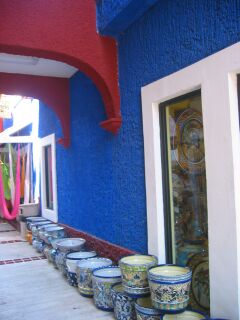March 01, 2004
Aniline dye

Looking though my Mexican photos, I am struck by the contrast between the monochromatic palette of nature and the palapas, and the vivid colors of the marketplace. Aniline dye was invented in 1856 by William Perkin. It made the production of vivid color possible. Before 1856 colors like turquoise, magenta and ultramarine blue were not to be found outside of nature, and stained glass. The Victorians were very excited by the possibilities of bright colors, and crassly overdid aniline applications for a while.
I used alot of aniline dye in my theatrical heyday. As I recall, we were warned of it's toxicity. A few granules in a garbage can full of water would be enough to stain an entire drop. Powerful stuff. It was also permanent, as in crazy glue. Once, a comrade took a microscopic bit home with her to do a piece; her Siamese cat got into it, and then groomed itself into permanent turquoise, tongue and all. The poor kitty probably suffered an early death. Coal tar. Or maybe it just cured it's psoriasis. Honestly, the things you learn on the web when you weren't meaning to learn anything at all.
My father always used Packer's Tar Soap. The revolting odor was one of the grave disadvantages of using his shower. It smelled like an oil change. He died from Parkinson's Disease at the age of 90, so I doubt its carcinogenic effects. That was pine tar, though. Just another loose association from the Dakota brain archive.